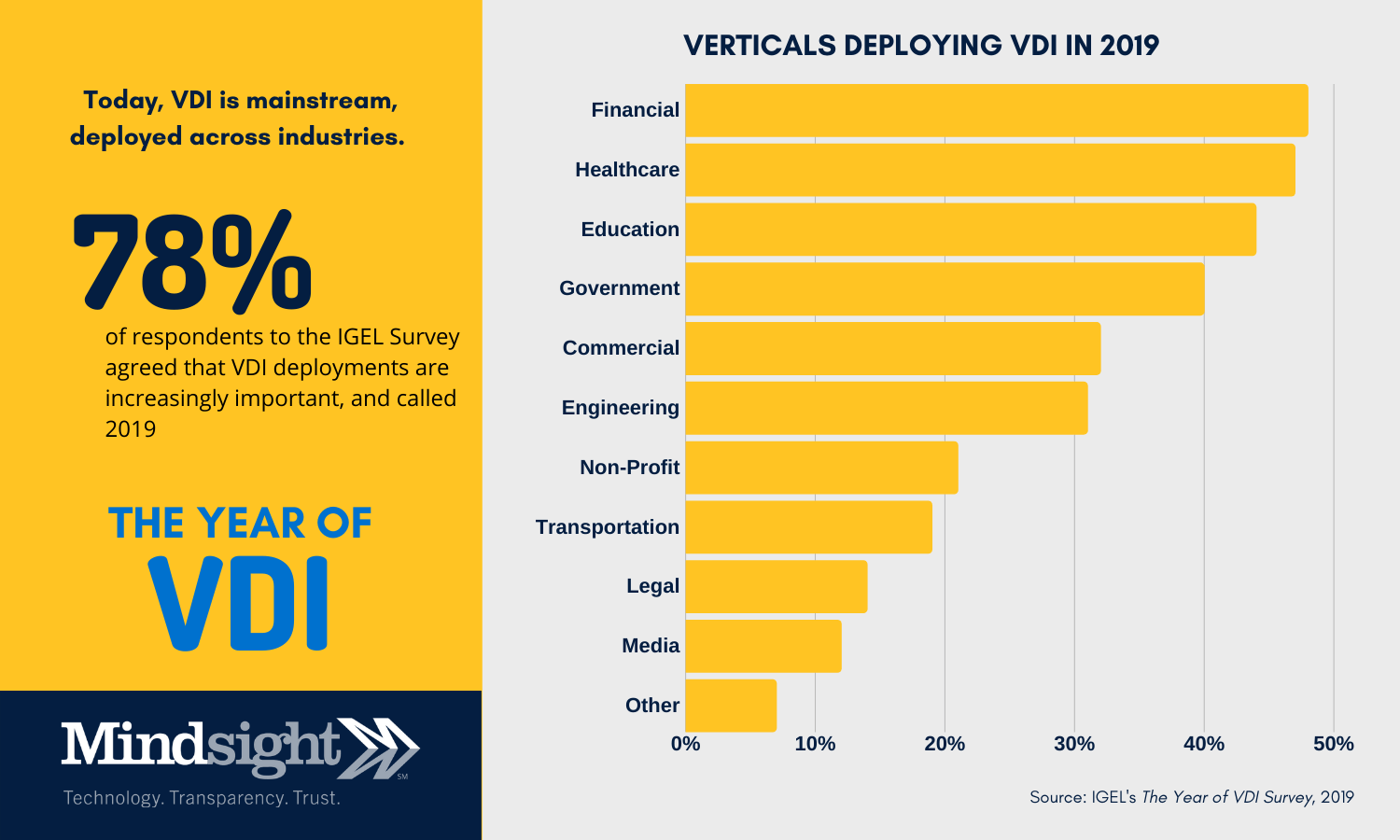January 30, 2020 by Siobhan Climer and Eric White
The global Virtual Desktop Infrastructure (VDI) market for the period of 2016 – 2023 is expected to have a CAGR of 27%, a high investment rate for a technology that emerged back in 2006 as an alternative to server-based computing.
What is driving this market growth? For one, VDI solutions are an integral element of most successful bring-your-own-device (BYOD) strategies and flexible workforce demands. In addition, the rise of cloud computing – and the many ways it has disrupted traditional concepts of computing and work – makes VDI more valuable than ever before.
Virtual Desktop Infrastructure (VDI) Overview

Skip this over if you’re a VDI virtuoso.
VDI is an approach to desktop virtualization that enables users to interact with the operating system (OS) and its applications delivered over a network to an endpoint device as if they were running locally.
In essence, it’s a return to the mainframe era of computing – when users would login remotely to the mainframe using a terminal, sharing a portion of the processor’s time and memory with other users.
In a circuitous development, the rise of personal computers (PCs) and multi-device workstations prompted technologists to move desktops back onto newer, faster, and more powerful servers.
There are two primary VDI platform versions: persistent and non-persistent VDI. Persistent VDI means the desktop persists. Each user can customize and save their virtualized desktop – similar to a traditional physical desktop set-up. Non-persistent VDI provides identical virtualized desktops that revert to an original state after a user signs off. Non-persistent VDI is common in computer lab environments – in libraries or on university campuses.
VDI Adoption Trends
Most organizations (80%) are already using VDI in some manner in their IT strategy. While the US and Canada continue to be the largest market for VDI, Asia Pacific countries, including China, Japan, and India, are the fastest growing market segment.
 Most of the growth of VDI technology is attributed to the growth of cloud deployments across the globe. In fact, the growth of the VDI market aligns closely to that of the cloud market across regions.
Most of the growth of VDI technology is attributed to the growth of cloud deployments across the globe. In fact, the growth of the VDI market aligns closely to that of the cloud market across regions.
As VDI solutions have matured, they have become less expensive and more reliable. In addition, changes to how and where users work is driving VDI adoption.
Key Factors Driving VDI Adoption Trends
VDI solutions are fundamental to the ways people work, which is why changes to the workplace are driving VDI adoption.
BYOD
Bring-your-own-device policies align closely VDI deployments. With users accessing their desktops from laptops, mobile phones, on the road, and at workstations, a persistent VDI provides simpler management from an IT perspective.

Flexible Workplace
More than 25% of US employees work remote at least part of the time, and this number is only expected to grow. The rise of remote and flexible work environments means IT must secure, deploy, and manage infrastructure accessible from different devices in different locations, a task simplified by VDI.
Cloud
The rise of cloud computing is also correlated with market growth around VDI. Gartner writes, “Through 2020, an increasing percentage of annual IT spending will be directly or indirectly impacted by a cloud shift.” VDI is a natural extension of a cloud migration, and now the desktop can be virtualized along with an organization’s data and its applications.

VDI No Longer Use Case Restrained
Historically, VDI solutions were primarily deployed in specific verticals, like engineering and media. Today, VDI is found in almost every industry, including finance, healthcare, education, government, transportation, and non-profits.
The Benefits And Drawbacks Of VDI
Just like any technology, VDI has its fans and critics. There are pros and cons to VDI, and what works for one business might not work for another.
Benefits of VDI
 Simplifies Management – VDI implementation can offer enormous benefits to IT teams. Instead of individually updating each desktop, IT can centrally manage and control desktops.
Simplifies Management – VDI implementation can offer enormous benefits to IT teams. Instead of individually updating each desktop, IT can centrally manage and control desktops.
Reduces Costs – Operation costs, administrative costs, and energy costs all usually take a significant cut with a VDI deployment.
Increased User Mobility – End users have much more flexibility with a VDI deployment, both in terms of their geographic location and the device they use.
Improved Security – Administrators have more control in a VDI environment; they can track usage, restrict users, set permissions, and intervene should a security threat become known.
Drawbacks of VDI
Increased Costs – Yes, reduced costs are a touted benefit of VDI; unfortunately, not every VDI deployment realizes this benefit. While it minimizes some hardware and administrative investments, the network needs to be fast and reliable. This means increased network requirements, which can – in turn – increase costs. VDI might only make sense when a hardware refresh is upcoming.
 Lack of Training – VDI, despite its maturity, doesn’t always cross the radar of IT professionals. A lack of training and education around VDI means businesses must rely on vendors or partners to deploy and manage the technology.
Lack of Training – VDI, despite its maturity, doesn’t always cross the radar of IT professionals. A lack of training and education around VDI means businesses must rely on vendors or partners to deploy and manage the technology.
Simplicity Versus Complexity – VDI is considered convenient, yet many of the conveniences can be outweighed by a greater chance for system-wide errors (with server-side issues) or a large number of unique VDI images leading to substantial storage requirements.
Is VDI A Solution For Your Business?
It depends. VDI can be a cost-effective tool that brings simplicity and flexibility to your organization’s environment – vital in today’s markets. At the same time, if deployed without proper evaluation or planning, it might add more complexity.
Creating a technology roadmap that considers the objectives of your business is a smart first step. Technology is a vehicle to bring your organization to where it needs to be. Once you determine the destination, only then can you decide whether VDI is the right investment for your organization.
Find out more about creating a technology roadmap with our free ultimate guide.
Like what you read?
Contact us today to discuss VDI and virtualization technologies.
About Mindsight
Mindsight, a Chicago IT services provider, is an extension of your team. Our culture is built on transparency and trust, and our team is made up of extraordinary people – the kinds of people you would hire. We have one of the largest expert-level engineering teams delivering the full spectrum of IT services and solutions, from cloud to infrastructure, collaboration to contact center. Our customers rely on our thought leadership, responsiveness, and dedication to solving their toughest technology challenges.
Contact us at GoMindsight.com.
About The Authors
Eric White is a Senior Solutions Architect at Mindsight, an IT Services and Consulting firm located in the Chicago area. With over ten years of experience in information technology and leadership, Eric excels at implementing network and data center technologies, designing high-yield solutions for the business. Holding professional certifications from Microsoft, VMware, and EMC, as well as the Cisco CCNP certification, Eric is an expert at solving business realities with a client-centric focus that delivers.
Siobhan Climer, Science and Technology Writer for Mindsight, writes about technology trends in education, healthcare, and business. She writes extensively about cybersecurity, disaster recovery, cloud services, backups, data storage, network infrastructure, and the contact center. When she’s not writing tech, she’s reading and writing fantasy, gardening, and exploring the world with her twin daughters. Find her on twitter @techtalksio.
5 Benefits of Hyperconvergence (HCI): An Infrastructure Report



